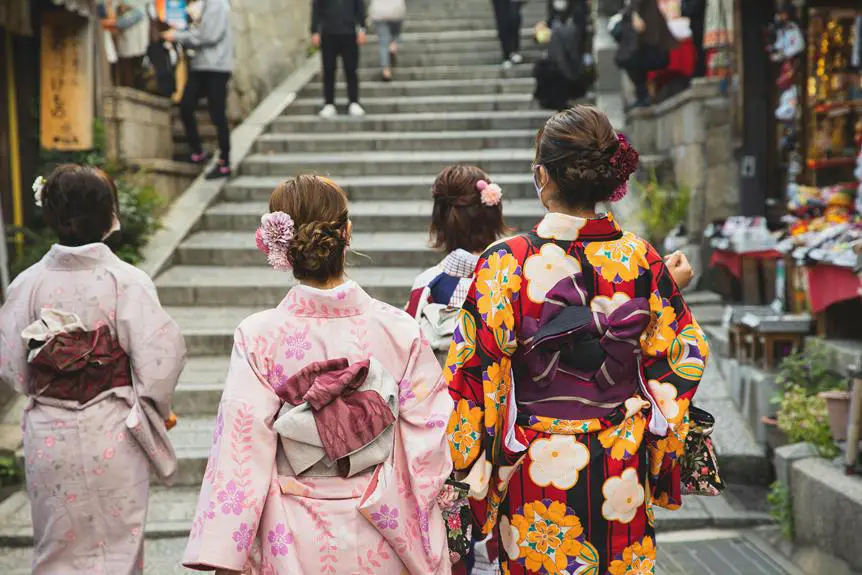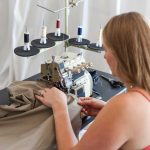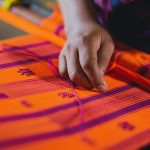When you think about the evolution of textile design, Jacquard weaving likely comes to mind as a pivotal moment in history. This innovative method, introduced by Joseph Marie Jacquard, not only transformed fabric production but also redefined fashion, particularly during the Victorian era. You might wonder how this intricate weaving technique influenced societal norms and personal expression through clothing. As you explore the intricate relationship between Jacquard fabrics and historical fashion trends, you'll uncover surprising connections that shaped an entire industry. What's next in this fascinating journey?
Table of Contents
Origins of Jacquard Fabric
Jacquard fabric originated in the early 19th century, revolutionizing textile production with its intricate patterns and automated weaving process.
You'll find that this innovative fabric emerged from the vision of Joseph Marie Jacquard, who developed a method that allowed for more complex designs than traditional hand-weaving techniques. This new approach enabled weavers to create detailed motifs without requiring extensive skill or time.
As you explore the origins of Jacquard fabric, you'll discover that its creation was a pivotal moment in the history of textiles. It marked a shift towards mechanization, setting the stage for future advancements in the industry. The ability to produce fabric with elaborate patterns efficiently not only satisfied the growing demand for decorative textiles but also reduced labor costs.
Jacquard fabric quickly gained popularity, influencing fashion and home decor across Europe and beyond. You can see how this fabric became a staple in high-end garments, upholstery, and drapery.
Its versatility and aesthetic appeal solidified its place in the textile market, making it a significant development in fashion history. Understanding the origins of Jacquard fabric helps you appreciate the intricate artistry that continues to inspire designers today.
The Jacquard Loom Revolution
You're about to explore the Jacquard Loom Revolution, a game-changer in the textile industry.
This invention not only streamlined production but also opened the door to intricate patterns and designs.
Let's uncover how this innovation transformed fabric-making forever.
Invention of Jacquard Loom
The invention of the Jacquard loom transformed the textile industry by introducing a more efficient way to produce intricate patterns in woven fabrics. Developed by Joseph Marie Jacquard in 1804, this loom utilized a system of punched cards to control the weaving process, allowing you to create complex designs with ease. This innovation not only simplified the craft of weaving but also increased productivity.
Here are some key features of the Jacquard loom:
- Punched Card System: The loom used cards with holes to dictate which threads lifted and which remained in place.
- Automation: It reduced human error, making it easier to replicate designs accurately.
- Versatility: You could create a wide variety of patterns, from simple to highly elaborate.
- Labor Reduction: Fewer skilled workers were needed to operate the loom, making it cost-effective.
Impact on Textile Industry
With the introduction of the Jacquard loom, the textile industry witnessed a revolution that significantly enhanced production efficiency and creativity in fabric design. You'd notice how this innovation allowed for intricate patterns to be woven directly into the fabric, eliminating the need for hand-weaving. The automated process not only sped up production but also reduced labor costs, making high-quality textiles accessible to a broader audience.
Here's a look at the key impacts of the Jacquard loom on the industry:
| Impact | Description | Outcome |
|---|---|---|
| Increased Efficiency | Automation of weaving patterns minimized manual labor. | Faster production rates |
| Enhanced Design Options | Allowed complex patterns and designs to be created easily. | Greater creativity |
| Cost Reduction | Lower labor costs led to affordable fabric prices. | Wider market access |
| Standardization | Consistent fabric quality became achievable. | Improved consumer trust |
This transformation set the stage for future advancements in textile manufacturing, influencing how you perceive fabric today. The Jacquard loom not only changed production methods but also empowered designers and manufacturers alike.
Patterns and Designs Evolution
Jacquard looms transformed fabric design by enabling the creation of intricate patterns that were previously impossible to achieve with traditional weaving techniques. This innovation not only changed the aesthetics of textiles but also revolutionized the entire industry.
You'd be amazed at how this technology allowed artisans to explore new creative avenues, leading to a vibrant array of designs that catered to various tastes and demands.
The evolution of patterns and designs through Jacquard looms brought forth:
- Complex Motifs: Detailed florals, geometric shapes, and intricate landscapes became easily woven into fabrics.
- Personalization: Consumers could request unique designs, tailoring textiles to individual preferences.
- Mass Production: The ability to produce intricate patterns at scale reduced costs and made luxurious fabrics accessible.
- Cultural Influence: Patterns reflected diverse cultural heritages, celebrating global artistry through fabric.
Ultimately, the Jacquard loom set the stage for modern textile design, influencing countless industries beyond fashion, from interior decor to automotive upholstery.
Jacquard in Victorian Fashion
Victorian fashion embraced the intricate beauty of Jacquard fabrics, showcasing vibrant patterns that transformed garments into works of art. As you explore this era, you'll notice how Jacquard's automated weaving technology allowed for elaborate designs that were previously unattainable. It catered to the Victorian love for opulence and detail, making it a staple in both everyday wear and high society.
You'll find Jacquard fabrics in dresses, waistcoats, and upholstery, often adorned with floral motifs, geometric shapes, and rich colors. This innovation not only enhanced the visual appeal but also allowed the middle class to access luxury that once belonged solely to the elite. Imagine stepping into a ball wearing a beautifully patterned Jacquard gown, its textures and colors capturing the light and attention of onlookers.
Moreover, the use of Jacquard in men's fashion reflected their status, with tailored suits showcasing intricate linings and patterns. This period marked a significant shift in fashion, where the interplay of technology and artistry elevated clothing into a form of self-expression. In Victorian times, you could truly see how Jacquard fabrics shaped the landscape of fashion, leaving a lasting legacy.
Baroque Influence on Jacquard
When you explore the Baroque influence on Jacquard, you'll notice how the opulent aesthetics of the era transformed textile design.
The intricate Jacquard weaving techniques allowed artisans to replicate the lavish patterns that defined Baroque style.
As you examine these influential patterns, you'll see how they laid the groundwork for future innovations in fabric design.
Baroque Aesthetics in Textiles
The lavish designs and intricate patterns of Baroque aesthetics have profoundly influenced the evolution of textile artistry, particularly in the realm of Jacquard weaves. You'll find that the dramatic flair of Baroque style, with its opulent motifs and vivid colors, has translated beautifully into Jacquard textiles, creating stunning visual effects that captivate the eye.
When you explore Baroque aesthetics in Jacquard weaves, consider these elements:
- Ornate Patterns: Flourishes, swirls, and elaborate designs that evoke a sense of grandeur.
- Rich Color Palettes: Deep, saturated colors—think golds, reds, and greens—that add depth and warmth to textiles.
- Textural Contrast: The interplay of smooth and raised surfaces that create a tactile experience.
- Symmetry and Asymmetry: The balance of elements that draw the viewer's attention while still feeling dynamic.
Jacquard Weaving Techniques
Baroque aesthetics not only inspired the visual elements of Jacquard textiles but also shaped the innovative weaving techniques that define this intricate craft. You'll notice that the Jacquard loom revolutionized how patterns were created, allowing for more complexity and detail than ever before. By employing a series of punched cards, the loom could control individual threads, leading to elaborate designs that reflect the grandeur of the Baroque period.
Here's a quick breakdown of key Jacquard weaving techniques influenced by Baroque:
| Technique | Description | Impact on Jacquard Textiles |
|---|---|---|
| Punched Card System | Uses cards to control thread movement | Enabled intricate designs |
| Multi-color Weaving | Incorporates various colored threads | Produced rich, vibrant textiles |
| Complex Patterns | Allows for layered and detailed motifs | Enhanced visual depth |
| Textural Variation | Combines different thread types | Adds tactile richness |
These techniques not only highlight the artistic flair of the Baroque era but also showcase the technological advancements that made Jacquard weaving a hallmark of textile innovation. By mastering these methods, you'll gain a deeper appreciation for the craftsmanship involved.
Influential Baroque Patterns
Influential Baroque patterns, with their intricate swirls and ornate motifs, significantly shaped the designs found in Jacquard textiles. When you explore these textiles, you'll notice how the lavishness of the Baroque style translates into fabric, creating a sense of opulence and depth. The Jacquard loom allowed for the reproduction of these complex designs, making them accessible to a broader audience.
Some key aspects of Baroque influence on Jacquard include:
- Ornate Curves: The flowing lines and curves create visual movement, drawing the eye across the fabric.
- Floral and Foliage Motifs: Nature-inspired elements are prevalent, symbolizing beauty and abundance.
- Symmetrical Balance: Baroque designs often exhibit symmetry, which adds a sense of harmony to the patterns.
- Rich Color Palettes: Deep, vibrant colors enhance the luxurious feel of the textiles, reflecting the grandeur of the Baroque period.
Artistry in Jacquard Design
Jacquard design showcases a unique blend of craftsmanship and creativity, transforming fabric into intricate works of art. When you explore the artistry behind Jacquard, you'll notice how each pattern tells a story, reflecting the designer's vision and cultural influences. This technique allows you to experiment with complex motifs, from floral designs to geometric shapes, all woven seamlessly into the fabric.
As you appreciate Jacquard design, consider how it balances tradition with innovation. Many contemporary artists draw inspiration from historical patterns while adding their personal touch, ensuring that each piece resonates with modern audiences. You might find that the textures and colors used can evoke specific emotions, making the fabric not just a material but a medium of expression.
Moreover, the versatility of Jacquard enables you to use it in various applications, from fashion to home décor. You can create stunning garments or elegant upholstery that stand out. As you delve deeper into this world, you'll discover that the artistry in Jacquard design is limitless, inviting you to both appreciate and participate in this rich tradition.
Technological Advancements in Weaving
Recent innovations in weaving technology are revolutionizing the way intricate Jacquard patterns are created, enhancing both efficiency and design possibilities. You might be surprised to see how these advancements not only streamline production but also expand creative horizons. With state-of-the-art machinery and software, designers can transform their visions into reality with remarkable precision.
Here are some key advancements shaping the future of Jacquard weaving:
- Computerized Looms: Modern looms can be programmed for complex patterns, significantly reducing manual labor.
- Digital Design Software: Designers can visualize and tweak patterns in real-time, ensuring the final product matches their vision.
- High-Speed Production: Enhanced machinery allows for faster weaving without sacrificing quality, catering to market demands.
- Sustainability Features: New technologies often incorporate eco-friendly practices, contributing to responsible production methods.
These technological strides not only improve the efficiency of Jacquard weaving but also empower you to experiment with new styles, ensuring the art form continues to evolve.
Jacquard's Modern-Day Relevance
Today, many designers and consumers alike appreciate Jacquard for its unique ability to blend tradition with contemporary aesthetics. This fabric not only offers intricate patterns but also serves as a canvas for modern expression. You'll find Jacquard in various applications, from high fashion to home décor, making it a versatile choice.
Here's a quick overview of Jacquard's modern-day relevance:
| Aspect | Description |
|---|---|
| Fashion | Designers use Jacquard for its rich textures and detailed designs, creating statement pieces that stand out. |
| Home Décor | Jacquard fabrics enhance interiors, offering elegance in upholstery, curtains, and cushions. |
| Technology | Digital Jacquard weaving allows for complex patterns, merging art with cutting-edge technology. |
| Sustainability | Many brands are now focusing on eco-friendly Jacquard options, appealing to environmentally-conscious consumers. |
Jacquard's evolution into modern-day use reflects a harmonious blend of artistry and innovation. As you explore the fabric, consider how it continues to influence both fashion and design, bridging the gap between heritage and modernity.
Frequently Asked Questions
What Types of Fibers Are Commonly Used in Jacquard Fabric?
Jacquard fabric commonly uses fibers like cotton, silk, linen, and polyester. Each fiber offers unique qualities; for instance, silk provides a luxurious feel, while polyester enhances durability. You'll find various textures depending on the chosen fiber.
How Do Jacquard Patterns Differ From Other Fabric Designs?
Jacquard patterns stand out because they're intricately woven, creating detailed images and textures. Unlike simpler designs, you can see depth and complexity, making each piece unique and visually captivating, perfect for adding flair to your projects.
Can Jacquard Fabric Be Used for Upholstery?
Yes, you can definitely use jacquard fabric for upholstery. Its intricate patterns and durability make it a stylish choice for furniture, adding texture and visual interest while standing up to wear and tear beautifully.
What Is the Cost Range for Jacquard Fabrics Today?
The cost range for jacquard fabrics today typically varies from $10 to $100 per yard, depending on quality and design. You can find options within this range at fabric stores or online retailers.
Are There Specific Care Instructions for Jacquard Garments?
When caring for jacquard garments, you should always check the care label first. Generally, hand washing in cold water works best, and avoid using bleach. Air drying helps maintain the fabric's structure and appearance.
- How Does Ring Spun Cotton Affect Garment Fit and Shape Retention? - August 13, 2024
- What Are the Challenges in Producing Ring Spun Cotton? - August 13, 2024
- Is Ring Spun Cotton Suitable for Plus-Size Clothing? - August 13, 2024




